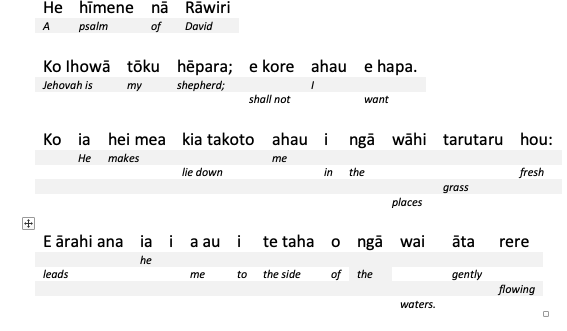Interleaved Māori and English text
I read an article recently titled "The New Old Way of Learning Languages". The article outlines a method of learning languages that involves reading texts in the target language with a literal translation of the text immediately below it in a language the reader knows.

I read an article recently titled "The New Old Way of Learning Languages". The article outlines a method of learning languages that involves reading texts in the target language with a literal translation of the text immediately below it in a language the reader knows.
The idea behind it, as far as I understand, is to enable the reader to quickly read texts in the target language that wouldn't normally be approachable due to a lack of vocabulary. Having the translated words immediately below the text enables quick scanning to find the meaning of the work, while staying in the flow of the target language. Through reading you pick up more of the vocabulary and grammar naturally.
There are books available in Te Reo Māori that have both English and Māori versions of the text. Sometimes these are Māori on one side of the page, English on the other - for example, Sleeps Standing/Moetū by Witi Ihimaera, translated by Hemi Kelly, or sometimes they are different books entirely like Harry Potter.
These are great for reading the te reo Māori version and using the English as a guide for unfamiliar vocabulary but often the Māori translation is a reimagining of the English in "whakaaro Māori" - Māori concepts. This is good for recreational reading of Māori text but makes it less useful for using the English as a guide for learning words and grammar. The Hamilton method outlined in the original article I quoted before prefers a literal translation of the words/phrases rather than a reconstruction of the idea to make learning easier.
To test out the method with Te Reo Māori I tried creating an example using Psalm 23 from Te Paipera Tapu. I found it difficult to do an interleaved English translation due to the fact that word ordering in English is quite different from Māori. Given the line "E ārahi ana ia i ahau i te taha o ngā wai āta rere", a literal interleave of the English was something like "Leads he me the side of the waters gently flowing." Not very readable.
Eventually I settled on an approach where the interleaved text is on multiple lines. The following image shows this sentence with the interleaved text:

In this snippet the English text is meant to be read from left to right, top to bottom. Each line contains a translation of the word in the standard English order, underneath the relevant Māori word in the original sentence.
When reading the Māori text you can scan the column below the Māori word to see the English. You can use the variation across the multiple lines to get an idea of how the word order is re-ordered to match the grammar of English.
I'm not entirely convinced this is useful but I'd like to produce some more texts in this style, and use them for reading practice and see how it goes. One issue with interleave texts that I come across is "cheating". That is, even though I can read the Māori text my brain gravitates to the English automatically and reads it when I don't need to. A similar issue exists when watching Māori language films with English subtitles. I tried to avoid this with a smaller font with the English text but there may be better options to explore.
I've put the PDF of the interleaved Māori and English Psalm 23 online. Note that the translation and layout is my rough draft to test the interleaving process and shouldn't be taken as any form of official text or translation of the Psalm. Comments and suggestions about the approach are welcome.
